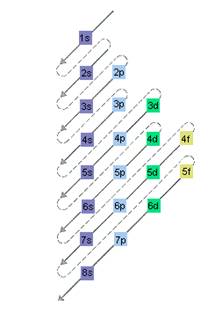
Interpretation: The common in terms of the electronic configuration of elements O, S and Se should be identified. The location of these elements in the periodic table should be determined.
Concept introduction: The rules for the allowed quantum numbers combinations are as follows:
- All the three quantum numbers ( n, l and m ) describes the orbital of an atom and they are integers.
- The principal quantum number, n value cannot be zero. Thus, the values allowed for the principal quantum number are 1, 2, 3, 4, and so on.
- The value of angular quantum number, l can be between 0 to n-1. Thus, if value of n is equal to 3 the value of l can be 0, 1 or 2.
- The value of magnetic quantum number, m can be between − l to +l . Thus, if value of l is equal to 2, m can be wither -2, -1, 0, +1, or +2
For same number of principal quantum number, an orbital form a shell. The first character denotes the shell and the second identifies the sub-shell.
Here, for s orbital value of
The relative energy of orbitals is represented as follows:

A s orbital can have maximum of 2 electrons, p orbital can have maximum of 6 electrons. Similarly, maximum electrons that a d and f orbital can have are 10 and 14 respectively.
Want to see the full answer?
Check out a sample textbook solution
Chapter 5 Solutions
EP BASIC CHEMISTRY-STANDALONE ACCESS
- Show work. Don't give Ai generated solutionarrow_forwardI'm confused can you help me for steps data analysis in AFMarrow_forwardHow many equivalents are in 15.0ml of 0.12 M BA(OH)2 solution? What volume of 0.085 M HNO3 is required to reach the endpoint when titration 15.0 ml of this solution?arrow_forward
- Why doesn't this undergo a 1,2-shift when it's in the carbocation stage of the reaction?arrow_forwardWhat are the molarity and the normality of a solution made by dissolving 25g of citric acid (triprotic acid, H3C6H5O7) in enough water to make 800ml of solution?arrow_forwardPlease correct answer and don't used hand raitingarrow_forward
- Please Don't use Ai solutionarrow_forward4. Redraw the following compounds from most reduced to most oxidized. If compounds have identical oxidation states, draw them under each other. OH میر محمد ملک OH OH .OH OH HS سلام پر من OH most reduced most oxidizedarrow_forwardPlease correct answer and don't used hand raitingarrow_forward
 Chemistry & Chemical ReactivityChemistryISBN:9781337399074Author:John C. Kotz, Paul M. Treichel, John Townsend, David TreichelPublisher:Cengage Learning
Chemistry & Chemical ReactivityChemistryISBN:9781337399074Author:John C. Kotz, Paul M. Treichel, John Townsend, David TreichelPublisher:Cengage Learning Chemistry & Chemical ReactivityChemistryISBN:9781133949640Author:John C. Kotz, Paul M. Treichel, John Townsend, David TreichelPublisher:Cengage Learning
Chemistry & Chemical ReactivityChemistryISBN:9781133949640Author:John C. Kotz, Paul M. Treichel, John Townsend, David TreichelPublisher:Cengage Learning

